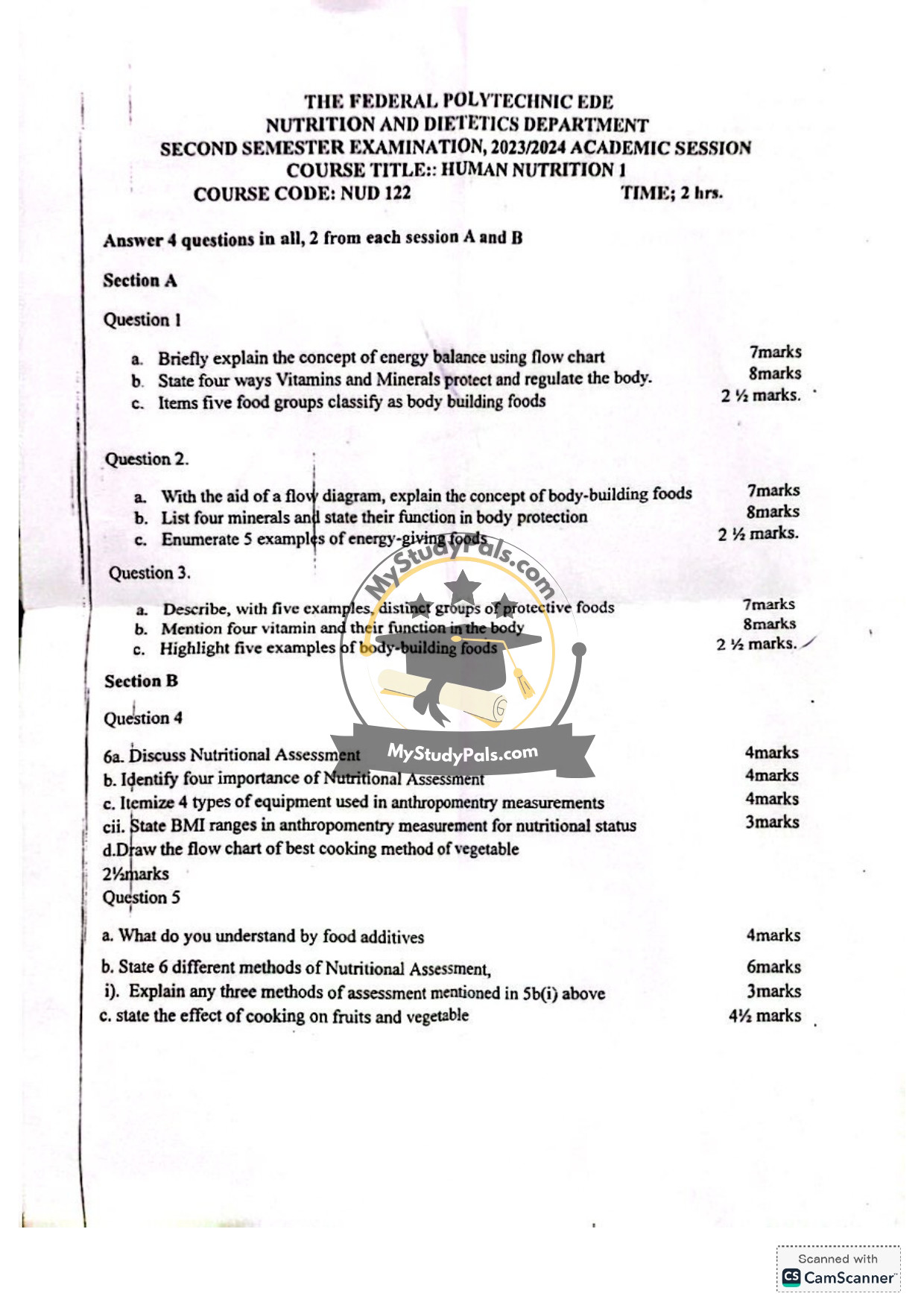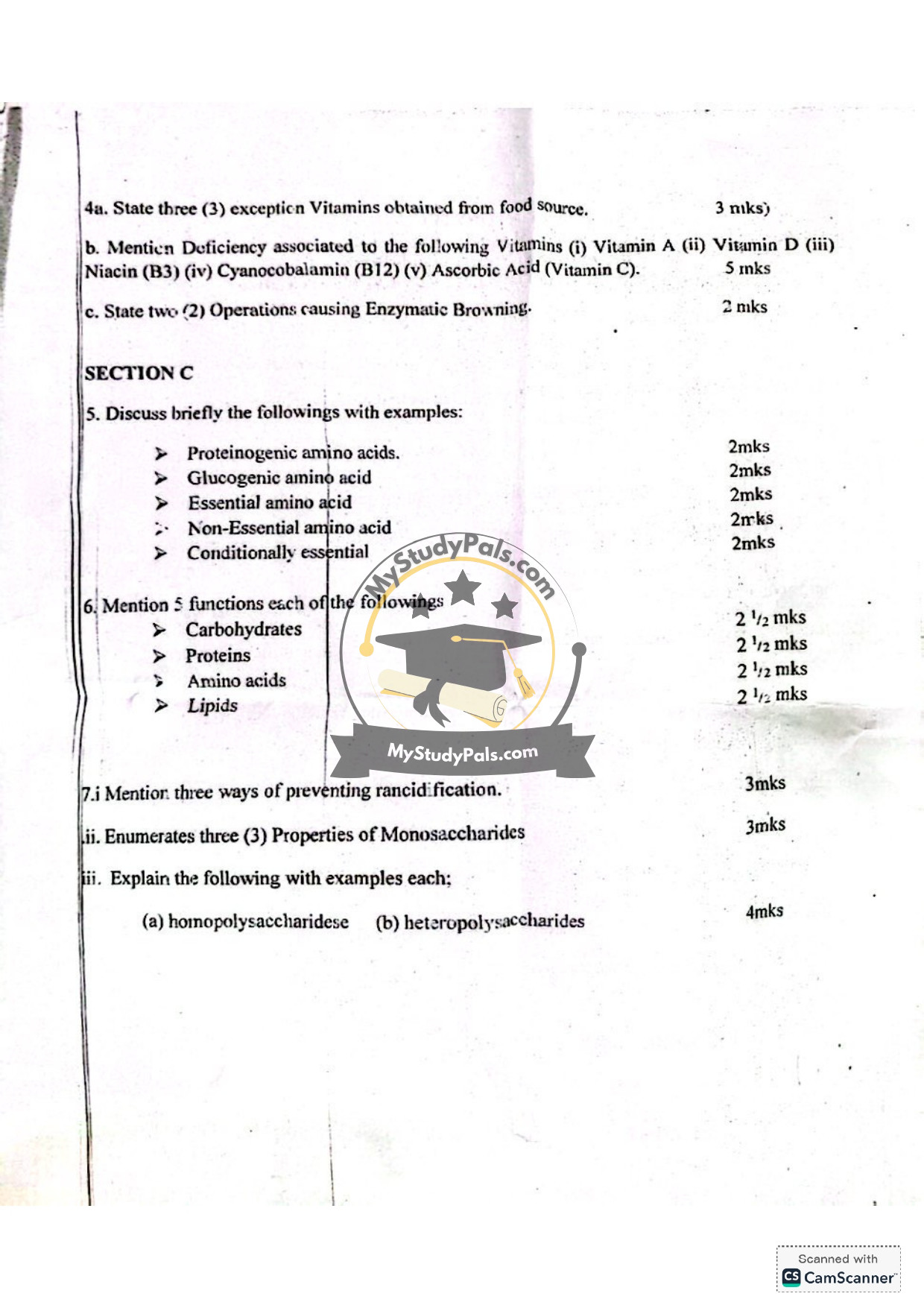ANWSER
Question 1:
a. Energy Balance Concept (Flow Chart Explanation):
Energy balance refers to the equilibrium between calories consumed (through food and drink) and calories expended (through metabolism and physical activity).
Flow Chart:
1. Energy Intake (Food & Drink) →
2. Energy Expenditure (Basal Metabolic Rate, Physical Activity, Thermic Effect of Food) →
3. Balance:
– Positive Balance (Intake > Expenditure) → Weight Gain
– Negative Balance (Intake < Expenditure) → Weight Loss
– Neutral Balance (Intake = Expenditure) → Weight Maintenance
b. Ways Vitamins and Minerals Protect/Regulate the Body:
1. Antioxidant Function: Vitamins C and E protect cells from oxidative damage.
2. Immune Support: Zinc and Vitamin D enhance immune response.
3. Bone Health: Calcium and Vitamin D maintain bone density.
4. Blood Clotting: Vitamin K is essential for coagulation.
c. Body-Building Food Groups:
1. Meat (e.g., chicken, beef)
2. Fish (e.g., salmon, tuna)
3. Eggs
4. Dairy (e.g., milk, cheese)
5. Legumes (e.g., beans, lentils)
—
Question 2:
a. Body-Building Foods Concept (Flow Diagram):
Body-building foods provide proteins and amino acids for tissue repair and growth.
Flow Diagram:
1. Protein Sources (Meat, Fish, Eggs, Dairy, Legumes) →
2. Digestion (Broken into amino acids) →
3. Absorption & Utilization (Muscle synthesis, enzyme production)
b. Minerals and Their Protective Functions:
1. Iron: Supports oxygen transport (hemoglobin).
2. Zinc: Boosts immunity and wound healing.
3. Selenium: Acts as an antioxidant.
4. Calcium: Strengthens bones and teeth.
c. Energy-Giving Foods:
1. Rice
2. Bread
3. Potatoes
4. Bananas
5. Honey
—
Question 3:
a. Protective Food Groups (Examples):
1. Fruits (e.g., oranges for Vitamin C)
2. Vegetables (e.g., spinach for iron)
3. Nuts/Seeds (e.g., almonds for Vitamin E)
4. Dairy (e.g., yogurt for probiotics)
5. Fish (e.g., salmon for omega-3 fatty acids)
b. Vitamins and Functions:
1. Vitamin A: Vision and immune function.
2. Vitamin D: Calcium absorption and bone health.
3. Vitamin B12: Nerve function and red blood cell production.
4. Vitamin C: Collagen synthesis and immunity.
c. Body-Building Foods:
1. Chicken breast
2. Eggs
3. Greek yogurt
4. Tofu
5. Quinoa
—
Question 4:
a. Nutritional Assessment:
Evaluation of dietary intake, anthropometry, biochemical tests, and clinical exams to determine nutritional status.
b. Importance of Nutritional Assessment:
1. Identifies malnutrition (under/over-nutrition).
2. Guides dietary interventions.
3. Monitors disease-related nutritional deficiencies.
4. Supports public health planning.
c. Anthropometry Equipment:
1. Weighing scale
2. Stadiometer (height measure)
3. Skinfold calipers
4. Measuring tape
cii. BMI Ranges:
– Underweight: <18.5
– Normal: 18.5–24.9
– Overweight: 25–29.9
– Obese: ≥30
d. Flow Chart: Best Cooking Method for Vegetables:
1. Selection (Fresh vegetables) →
2. Preparation (Washing, cutting) →
3. Cooking Method (Steaming/Sautéing to retain nutrients) →
4. Serving (Minimal processing).
—
Question 5:
a. Food Additives:
Substances added to food to preserve flavor, enhance taste, or improve appearance (e.g., preservatives, colorants).
b. Nutritional Assessment Methods:
1. 24-hour Dietary Recall
2. Food Frequency Questionnaire
3. Anthropometry
4. Biochemical Tests
5. Clinical Examination
6. Dietary History
i. Explanation of 3 Methods:
1. 24-hour Recall: Patient recounts all foods consumed in the past 24 hours.
2. Anthropometry: Measures body dimensions (e.g., BMI, waist circumference).
3. Biochemical Tests: Blood/urine analysis for nutrient levels (e.g., hemoglobin).
c. Effect of Cooking on Fruits/Vegetables:
1. Nutrient Loss: Heat degrades Vitamin C and B vitamins.
2. Enhanced Bioavailability: Cooking increases lycopene (tomatoes) and beta-carotene (carrots).
3. Texture Change: Softens cellulose fibers.
—
Section C Answers:
4a. Exception Vitamins:
1. Vitamin D (synthesized from sunlight).
2. Vitamin K (produced by gut bacteria).
3. Niacin (can be synthesized from tryptophan).
b. Vitamin Deficiencies:
(i) Vitamin A: Night blindness
(ii) Vitamin D: Rickets
(iii) Niacin: Pellagra
(iv) B12: Pernicious anemia
(v) Vitamin C: Scurvy
c. Enzymatic Browning Causes:
1. Cutting/peeling fruits (e.g., apples).
2. Bruising (e.g., bananas).
—
Question 5 (Section C):
Proteinogenic Amino Acids:
Amino acids incorporated into proteins (e.g., leucine, glycine).
Glucogenic Amino Acids:
Converted to glucose (e.g., alanine).
Essential Amino Acids:
Cannot be synthesized; must be consumed (e.g., lysine).
Non-Essential Amino Acids:
Synthesized by the body (e.g., glutamine).
Conditionally Essential:
Required during illness/stress (e.g., arginine).
—
Question 6:
Carbohydrates Functions:
1. Energy source
2. Brain fuel (glucose)
3. Dietary fiber for digestion
Proteins Functions:
1. Tissue repair
2. Enzyme production
3. Immune support (antibodies)
Lipids Functions:
1. Energy storage
2. Cell membrane structure
3. Hormone synthesis
—
Question 7:
i. Preventing Rancidification:
1. Refrigeration
2. Antioxidants (e.g., Vitamin E)
3. Airtight packaging
ii. Monosaccharide Properties:
1. Sweet taste
2. Water-soluble
3. Reducing sugars (e.g., glucose)
iii. Polysaccharides:
– Homopolysaccharides: Single sugar type (e.g., starch—glucose).
– Heteropolysaccharides: Multiple sugars (e.g., hyaluronic acid—glucuronic acid + N-acetylglucosamine).



